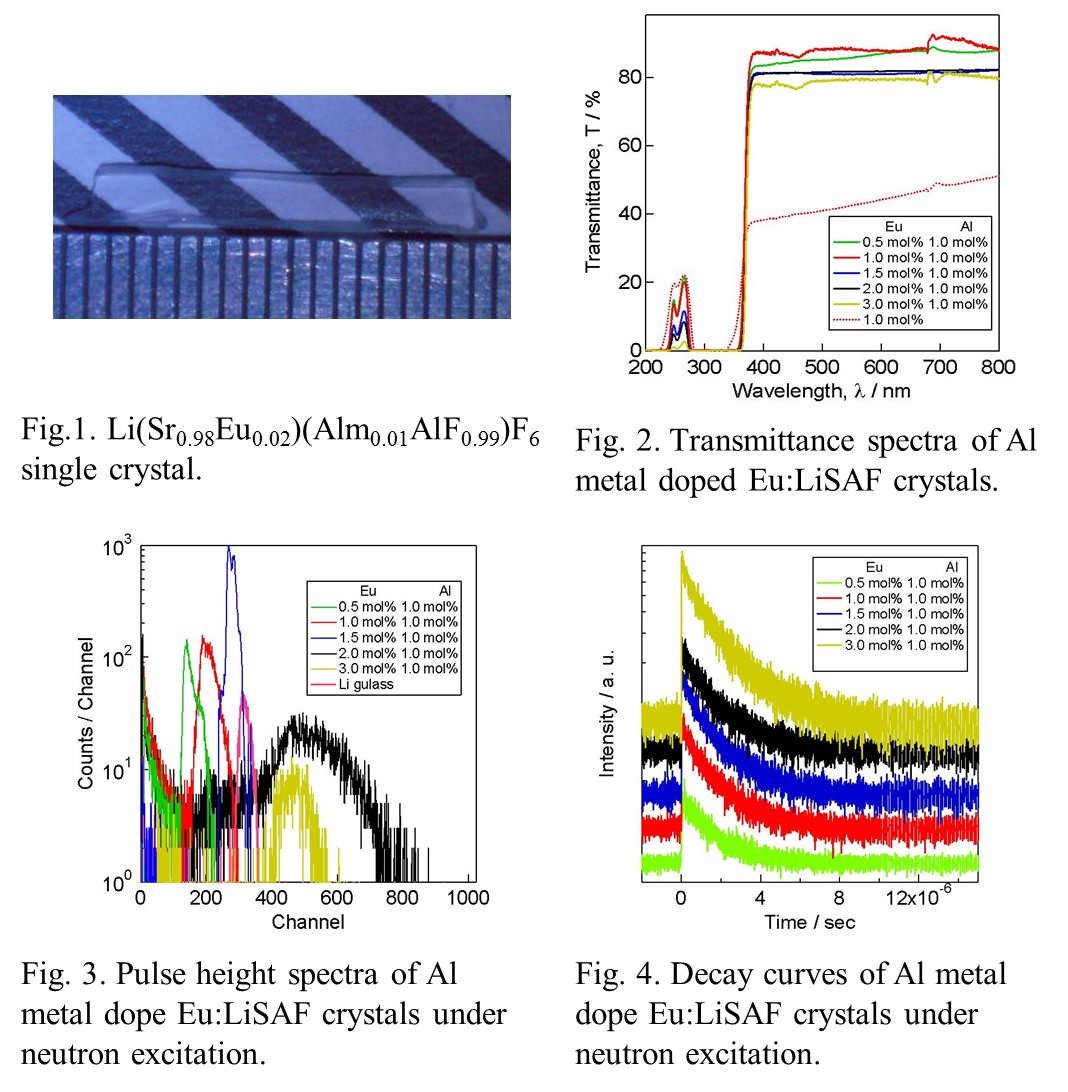The interest in the neutron detection techniques have been increasing due to the increase of the need for neutron detectors in various applications. The proportional counters filled with3He gas have been mainly used in the applications because of the large cross-section to thermal neutron and low sensitivity to gamma-ray background. However, in recent years, great demand of the 3He gas for homeland security applications resulted in the 3He supply crisis, and then the development of alternative neutron detector has been strongly required. We have investigated the Ce3+ and Eu2+ dope LiCaAlF6 (LiCAF) and LiSrAlF6 (LiSAF) crystalline scintillators with relatively high light yield to thermal neutron as an alternative for the 3He gas [1-3]. The Eu:LiCAF and Eu:LiSAF scintillator crystals have attractive performance such as high light yield and non-hygroscopic properties. However, the transparency drastically decreases due to the formation of milky parts which include the secondary phase by the increase of Eu concentration. The formation of secondary phase is attributable to the low effective segregation coefficient (keff) of Eu ion into the LiCAF and LiSAF crystals and this fact seriously decrease the yield of the bulk crystals.
In this study, we grew Eu:LiSAF single crystals using Al metal as starting material to decrease the formation of milky parts and the optical and scintillation properties were investigated. Usually, the LiSAF single crystals were grown from LiF, SrF2, AlF3, EuF3 starting material powders. However, the Eu3+ ion in EuF3 substitutes to the Sr2+ site as a Eu2+ ion. Therefore, we tried to remove the extra fluorine ion (F-) by doping of Al metal.
The Eu doped LiSAF crystals were grown as nominal compositions of Li(Sr1-xEux)(Alm0.01AlF0.99)F6 (x = 0.005, 0.01, 0.015, 0.02, 0.03) using starting materials of 4N LiF (7.5% 6Li), SrF2, AlF3, EuF3 (produced by Stera Chemifa) and Al metal powders. Alm and AlF are Al from Al metal and AlF3, respectively. Crystal growth was performed by the micro-pulling-down (μ-PD) method with the tight-vacuum chamber. Mixed powders were set in the graphite crucible with a Φ3 mm die which has a Φ2 mm hole in the center and the crucible was heated by the high-frequency induction coil in Ar/CF4 mixed gas after baking process under high vacuum (~10-4 Pa). The melt in the crucible was pulled down using Platinum wire as the seed at approximately 0.1 mm/min. The detail of crystal growth by the μ-PD method was described in Ref. [4]. Rectangular samples with 1 mm thickness were obtained from the grown crystals and they were polished for the optical and scintillation measurements. Transmittance was measured by JASCO V550 spectrofluorometer in the range of 190-900 nm. Pulse height spectra and decay time under neutron excitation from 252Cf radiation source were investigated. In the measurements, 6Li-loaded glass scintillator (GS20; Saint Gobain) with the size of 1 × 2 × 6 mm3 which had the light yield of 6000 ph/n [5] was used as a reference. The crystals were optically coupled to the window of photomultiplier tube (PMT, Hamamatsu R7600U) with an optical grease (OKEN 6262A).
The polished Li(Sr0.98Eu0.02)(Alm0.01AlF0.99)F6 single crystal is shown in Fig.1. The crystal indicated high transparency and there was no milky part in the all grown crystals. Transmittance of Al metal doped crystals showed approximately 80 % in the wavelength range of 380-900 nm, as it is illustrated in Fig. 2. In contrast, the crystals without Al metal indicated less than 50% transmittance due to the milk parts. In addition, the crystals had strong absorption peaks which were attributable to the 4f-5d transitions of Eu2+ ion at 200 and 300 nm. By the increase of Eu concentration, the intensities of absorption peaks systematically increased.
Figure 3 shows the pulse height spectra of Al metal doped Eu:LiSAF crystals. By way of comparison, the result of 6Li-loaded glass scintillator was also indicated. Light yield of Al metal doped crystals systematically increased with the increase of Eu concentration up to 2 mol%. Meanwhile, the light yield of Eu 3 mol% doped crystal was almost same as that of Eu 2 mol% doped crystal. Decay times of Al metal doped crystals were 1400-1700 ns, as shown in Fig.4. Other optical and scintillation properties will be reported. 
Reference
[1] A. Yoshikawa, T. Yanagida, Y. Yokota, N. Kawaguchi, S. Ishizu, K. Fukuda, T. Suyama, K. J. Kim, M. Nikl, M. Miyake, M. Baba, IEEE Trans. Nucl. Sci., 56 (2009) 3796-3799
[2] A. Yamaji, N. Kawaguchi, Y. Fujimoto, Y. Yokota, K. Watanabe, J. Pejchal, Nucl. Instr. Meth. Phys. Res A. 659 (2011) 368-372.
[3] T. Yanagida, N. Kawaguchi, Y. Fujimoto, Y. Yokota, A. Yamazaki, K. Watanabe, A. Yoshikawa, V. Chani, Measurements 46 (2011) 1708-1711.
[4] A. Yoshikawa, G. Boulon, T. Fukuda, Opt. Mater. 30 (2007) 6.
[5] E. Van, C.W.E., Radiat. Prot. Dosim. 110 (2004) 5-14. |